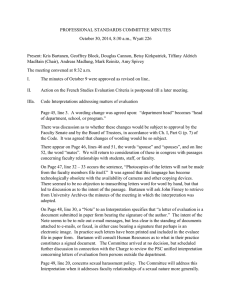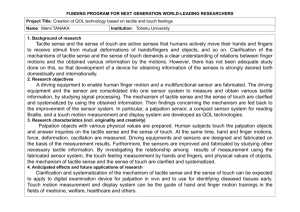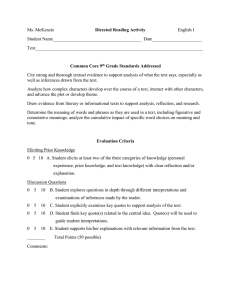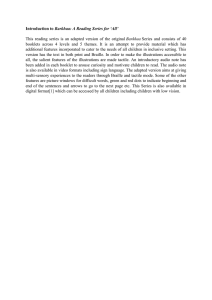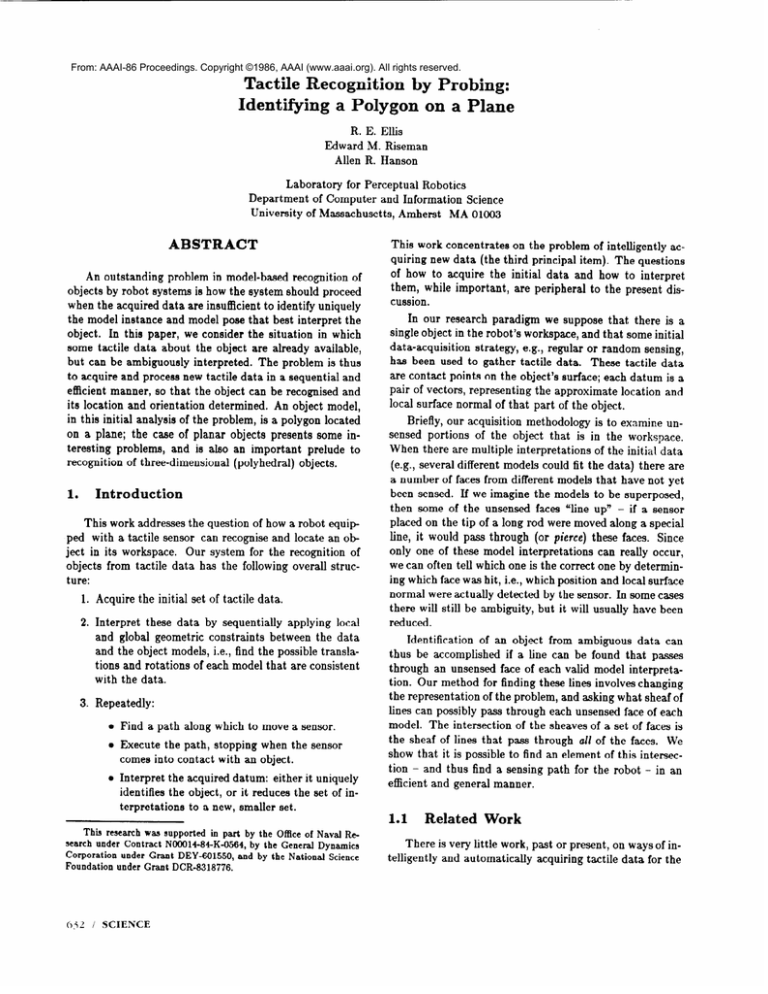
From: AAAI-86 Proceedings. Copyright ©1986, AAAI (www.aaai.org). All rights reserved.
Tactile Recognition by Probing:
Identifying a Polygon on a Plane
R. E. Ellis
Edward M. Riseman
Allen R. Hanson
Laboratory for Perceptual Robotics
Department of Computer and Information Science
University of Massachusetts, Amherst, MA 01003
ABSTRACT
An outstanding problem in model-based recognition of
objects by robot systems is how the system should proceed
when the acquired data are in8ufRcient to identify uniquely
the model instance and model pose that best interpret the
object. In this paper, we consider the situation in which
some tactile data about the object are already available,
but can be ambiguously interpreted.
The problem is thus
to acquire and process new tactile data in a sequential and
eflicient manner, so that the object can be recognised and
its location and orientation determined. An object model,
in this initial analysis of the problem, is a polygon located
on a plane; the case of planar objects present8 8ome interesting problems, and is also an important prelude to
recognition of three-dimensional
(polyhedral) objects.
1.
Introduction
This work addresses the question of how a robot equip
ped with a tactile sensor can recognise and locate an object in its workspace. Our system for the recognition of
objects from tactile data haa the following overall structure:
1. Acquire the initial set of tactile data.
2. Interpret these data by sequentially applying local
and global geometric constraints between the data
and the object models, i.e., find the possible translations and rotations of each model that are consistent
with the data.
3. Repeatedly:
l
Find a path along which to move a sensor.
e Execute the path, stopping when the sensor
come8 into contact with an object.
0 Interpret the acquired datum: either it uniquely
identifiee the object, or it reduces the set of interpretatione to a new, smaller set.
This research was supported in part by the Office of Naval Research under Contract NO0014-84-K-0564, by the General Dynamics
Corporation under Grant DEY-601550, and by the National Science
Foundation under Grant DCR-8318776.
6j2
/ SCIENCE
This work concentrate8 on the problem of intelligently acquiring new data (the third principal item). The questions
of how to acquire the initial data and how to interpret
them, while important, are peripheral to the present discussion.
In our research paradigm we suppose that there is a
single object in the robot’8 workspace, and that some initial
data-acquisition
strategy, e.g., regular or random sensing,
haa been used to gather tactile data. These tactile data
are contact points on the object’s surface; each datum is a
pair of vectors, representing the approximate location and
local surface normal of that part of the object.
Briefly, our acquisition methodology is to examine unsensed portions of the object that is in the workspace.
When there are multiple interpretations
of the initial data
(e.g., several different models could fit the data) there are
a number of faces from different model8 that have not yet
been sensed. If we imagine the model8 to be superposed,
then some of the unsensed face8 “line up” - if a sensor
placed on the tip of a long rod were moved along a special
line, it would pass through (or pierce) these faces. Since
only one of these model interpretation8
can really occur,
we can often tell which one is the correct one by determining which face was hit, i.e., which position and local surface
normal were actually detected by the 8ensor. In 8ome cases
there will still be ambiguity, but it will usually have been
reduced.
Identification
of an object from ambiguous data can
thus be accomplished if a line can be found that passes
through an unsensed face of each valid model interpretation. Our method for finding these lines involveschanging
the representation of the problem, and asking what sheaf of
lines can possibly pass through each unsensed face of each
model. The intersection of the sheaves of a set of faces is
the sheaf of lines that pass through all of the faces. We
show that it is possible to find an element of this intersection - and thus find a sensing path for the robot - in an
efficient and general manner.
1.1 Related
Work
There is very little work, past or present, on ways of intelligently and automatically acquiring tactile data for the
purposes of object identification.
There are only two reasonably well-known work8 of significance: that of Allen and
Bajcsy, [ 11, and Luo et al. [6]. The former work used vision
to reduce the number of possible models, and used surfacefollowing to verify the model instance; this approach, while
effective in the experiments they describe, is very timeconsuming. The latter work also used vision initially, and
simple tactile feature8 subsequently, to search through a
decision tree; the sensing strategy is very simple, consisting of repeated rotation of the Sensor about the object.
While it is effective in simple cases, the author8 point out
its shortcoming8 in dealing with smooth or highly symmetric objects.
The recognition methodology we follow here is that of
Grimson and Lozano-Perez, who in several papers have detailed a model-based tactile recognition approach [3], [4],
[S]. In this methodology, an object is represented as a polygon, i.e., as a set of line segments. The tactile data consist
of a position, a local surface normal, and the maximum
error value of each of these quantities (an error circle and
error cone, respectively).
Interpretation
of tactile data
consists in finding an assignment of each datum to a model
face.
Our approach extends this methodology by showing
how to acquire new data when multiple valid interpretations exist. Interpretation
of these new data is very rapid,
because the path along which the sensor is moved has been
calculated from the known valid interpretations;
there are
very few assignments of a newly acquired datum, and most
of the possible assignments can be rapidly predicted from
the geometric relationships between the path and the models. The approach presented here, and related issues, are
discussed more fully in [2].
2.
Piercing
a Set of Line Segments
The principal conceptual problem in finding a path
along which to move a tactile sensor is that of finding a
line that pierce8 a number of line segments (or faces - the
terms will be used interchangeably
below). The line is the
sensing path, and the segments are unsensed faces from the
various interpretation8
of the data. There are a number of
other non-trivial considerations,
e.g., how to evaluate the
path and how to find it efficiently, but the core problem is
that of finding the parameter8 of a line that passes through
a set of segments.
2.1
Finding
the Path Parameters
In the plane, a line has two degrees of freedom, one of
position and one of direction. It is possible to restrict the
starting position of the sensing path to lie on some locus;
without loss of generality, let us suppose that the starting
locus is the X axis.’ The endpoints of each face can be
expressed as a pair of points, and the face is a line segment
between these points. Thus, we seek the parameter8 of a
line that intersects the X axis, and pierces each of a given
set of line segments.
The path parameters can be expressed as an X intercept, and a direction. In order to make it clear that some
later formulae have important linear forms, the path direction will be expressed as the slope (Yof the line, taken with
respect to the Y axis. That is, if the angle between the
path and the Y axis is 8, we will deal only with the slope
of the line which is o = tan8.
From these preliminaries,
the procedure for finding a
sensing path can be developed. Beginning with the simplest possible case, suppose that we wish to find a path
that intersects a particular point P. The bounds on the
slopes of the lines passing through P will be referred to as
amin and amar.
The crucial observation is that the problem can be inverted from finding a path that pierces the point, to finding
the sheaf of line8 going through the point that satisfy the
constraints. For any given slope a, the line passing through
the point P intersects the X axis at a single, determinable
point that we will denote as Q. Let us call the intemection of this line with the X axis the projection of P. The
projection function, which varies with the slope of the line,
is
This function yields the point on the X axis that pierce8
the point P with a path whose slope is a.
Now, we can represent this projection function a8 a line
in a new, Euclidean space. One axis of this space is the
original X axis, and the other is the angular A axis (pronounced “alpha”). In this new space, the projection function may be represented as
Q&)
= (Px - a*PY , f-g
(1)
This function may be interpreted a8 giving the position of a
point Qp in X-A space, derived by projecting the original
point P (in X-Y space) onto the X axis in the direction a.
By virtue of the definition of this line, it ha8 a very
useful property: the coordinate8 of any point on this line
directly encode the parameters of a path starting on the X
axis that pierces the original point P. The projection line
Qp in X-A space thus completely describes the sheaf of
paths that pierce P, under the constraints we have set, out
above.
From this basis, we can derive more useful results. In
two dimensions, we wish to pierce not points but line segments. This more complex problem can be solved by employing the parametric representation
of a line, and using
Equation 1 to determine how each point on the line segment would project.
We can represent
a line parametrically
a8 a point and
‘We may rotate and translate an arbitrary starting
line so that it
coincides with the X axis, and transform the faces according~.
PERCEPTION
AND
ROBOTICS
/ 63.1
A
a displacement along some direction; letting the point be
P and the direction vector D, the equation for a line is
in Equation 1 gives the
WI = P + A. D. Substitution
projection formula of a line, which is a function of the path
slope a and the line parameter A, a8
QL(A,a) = (Lx(A)=
Q-LY(q
94
(Px + A*Dx - a.Pv - AeDy
a’
(2)
Figure 2: Two edges in X-A space, and their intersection.
that passes through the face8 whose projection is part of
this intersection.
Once these parameter values have been
found, the rotation and translation can be reversed, and
the start point and path direction expressed in the natural
coordinates of the X-Y plane.
3.
Computing
Note that the locus of point8 in
by this projection, when cy and X
dently, is a trapezoid. In particular,
of the trapezoid are parallel to the
segments have the slopes described
X-A that is
are bounded
the parallel
X axis, and
above.
described
indepensegments
the other
The points in the interior of this trapezoid have the
property that their coordinates represent the parameter8
of a sensing path that pierce8 the desired line segment. If
we take two distinct line segments, and project each into
X-A epace, the result is two trapezoids. The intersection
of these two trapezoids is a convex set of points, whose
coordinates describe the parameters of the set of paths that
intersect both of the origin4 line segments. Figure 2 shows
the projection of two distinct edge8 in X-A space; the area
of intersection is the set of points that specifies the sheaf
of paths that pierce both original edges.
The general two-degree-of-freedom problem can thus be
expressed, in these new terms, as finding a point that is in
the interior of the intersection of a number of trapezoids in
X-A space. The coordinates of any interior point-represent
the position on the X axis and the direction Q of a line
634 I SCIENCE
a Sensing Path
Our approach to calculating a sensing path involves examining each unsensed face I$ in turn, and trying to find
a path through it and as many other face8 as possible. A
real-world constraint is that when a sensor contacts a surface at too oblique an angle, it either skids off or returns
unreliable data. We can thus form the set of unsensed face8
{J”i. .. &-‘k}such that the angle between the normal of Fi
and the normal of any face in the set is less than the sensor
skid angle; let us call this the candidate set formed from
F;.
our algorithm
1. Calculate
of an edge into X-A space.
I
I
aminI\
In outline,
Figure 1: Projection
7
I
I
I\
, a)
where the subscripts indicate component8 of the line, point,
and direction. This formula is non-linear in a and A. However, for 6xed A, it is linear in a; in particular, the endpoints of a segment project into lines in X-A space. If
Dy is nonzero, i.e., if the line segment is not parallel to
the X axis, then by Equation 2 the projected line8 of the
endpoints will have different slopes. Figure 1 shows a projection of an edge into X-A space; the boundary is not a
parallelogram because the edge was originally tilted with
respect to the X axis. The left and right line segments
represent the projections of the edge boundary points PI
and P2 into X-A space.
--
*ma2
for finding a sensing path is:
the candidate
set of each unsensed face.
2. Sort the candidate sets according to how many interpretations are present in each.
3. Find and test a feasible path through each candidate
set:
(a) Find the projection parameter a’ which creates
the maximum overlap of candidate faces with
the generating face Fi.
(b) Find an X value, in this projection,
the intersection of the projections.
that is in
(c) Determine the ability of the path to distinguish
amongst the current interpretations.
This algorithm is more fully described in [2]. Here, we
will only outline the computational
approach, describe the
complexity of the algorithm, and discuss some of the path
evaluation issues.
3.1
Computing
the Path Parameters
In X-A space, the projection of a given face is a convex
polygon, and the coordinates of points in its interior and
boundary represent parameters of the sheaf of lines passing
through the face. Thus, the parameters of the sheaf passing
through a set of faces is represented by the intersection of
the sheaves of each face, which is also a convex polygon; let
us call this the sheaf polygon. The problem we must solve,
then, is Anding a single point in the interior of the sheaf
polygon that is produced by intersecting the projections of
as many faces, from different interpretations,
as is possible.
Our method for finding a point in the sheaf polygon
is to examine only the regions near its vertices. Because
a vertex is formed from the intersection of the projections
of endpoints of different faces - which we call the critical
points of the projection - this simple geometric observation
reduces the search from a full two-dimensional
one to a
search over a finite set of points. Combinatorially,
there
are in general O(Nz) points to examine if there are N faces
in a candidate set. Figure 3 shows the projections of three
edges and the critical points that lie within the [a,,,{,,, (r,,,]
bounds; some of the critical points in this example have the
same cy value. The region labelled S (which is bounded
above by the line (Y = (Y,,,) is the sheaf polygon for all
three edges.
A
A
These conditions must be examined to determine how good
a path is at reducing the number of interpretations.
Three properties of tactile sensors are that they have
a finite ability to discriminate depth and contact normals,
and that if the contact angle is too oblique then the sensed
normal value is either unreliable, or unavailable because the
sensor skids off the object surface. Once a path has been
found, all pierced faces must be examined to determine how
these constraints apply. It often happens that unsensed
faces appear in similar two-dimensional configurations, and
so they could not be distinguished by a tactile sensor.
We address such cases by forming an ambiguity tree
for the interpretations.
At each level of this wary tree, the
nodes represent the set of interpretations
that are possible
if a particular sense datum (or class of sense data) are
found. The width of the tree at any level indicates how
many equivalence classes of interpretations
there are with
respect to the path from which it was formed, and the
depth indicates how many paths must be followed by the
sensor, in the worst case, if the object in the workspace is
to be uniquely identifled.
An example ambiguity tree is given in Figure 4. Beginning at the root, there are 21 interpretations;
the first
path uniquely identifies 5 of these, one datum indicates an
equivalence class of 2 interpretations,
and if any other datum were detected (or if no contact took place) then more
motion would be required do distinguish among the remaining 14 interpretations.
For this complex tree, at most
4 paths would have to be traversed to identify the object,
but most likely only 2 would be needed.
4.
Figure
3: Three edges in X-A space, and their critical
points.
Once these critical points have been found, we must
determine how many faces have projections that contain
each of these points. This test is simple, but adds a level
of complexity to the algorithm, since we must check N
faces for each of O(w) critical points; the net worst-case
complexity is thus O(NS). In practice, however, very good
paths can be found well before this worst-case behaviour
becomes significant.
3.2
Evaluating
a Sensing
Path
That a path intersects several unsensed faces does not
imply that a tactile sensor can determine which face has
been contacted. There are limits to the ability of sensors
to discriminate depth and orientation, and regardless, it is
possible for several unsensed faces to be exactly coincident.
Experimental
Result8
An extensive series of simulations have been performed
using this algorithm and the six polygonal test objects
shown in Figure 5. The experiments involved using only
two tactile data, which are shown in the midst of the
objects; the dots are the positional information, and the
spikes the direction of the local surface normal.
These
data were chosen because of the considerable ambiguity
with which they can be interpreted. There was a very smalI
amount of positional error associated with each datum, and
a normal direction error of about 4 degrees. Table 1 gives
the number of valid interpretations
of each object.
Table 1: Interpretations
Object
Name
robot-hand
human-hand
telephone
boot
camera
beer-bottle
1 Number of
Faces
of 2 points.
Number of
Interpretations
12
4
3
2
3
6
3
18
12
13
12
8
PERCEPTION
AND
ROBOTICS
/ 635
The simplest experiments attempted to distinguish the
four poses of the Robot-Hand
object. A number of paths
will uniquely identify these four interpretations.
Figure 6
shows the four interpretations;
the circles indicate where
the identifying path contacts the object, and the dots and
spikes indicate the position and sensed normal of the given
tactile data. It was assumed that the sensor could determine local surface normal and depth very well and had a
sensor skid angle of 89 degrees, i.e., any slight touch of
the surface would be suficient to gather data. The path
actually contacts each face parallel to its surface normal,
so the latter design parameter could be tightened considerably without affecting the result.
Of interest was how many distinct interpretations
of
these data could be identified with a single path. The answer is, with the above path constraints, that 20 out of the
21 can be contacted, 17 of these being terminal nodes in the
ambiguity tree. (A second path is required to distinguish
among the remaining interpretations.)
Table 2 summarises
the results of various runs, indicating the models used, the
number of possible interpretations,
and the number of interpretations
that had at least one path pierced.
Table 2: Distinguishing
Objects
Identification.
Interpk
pierced
-
Pass
Verification
Candidate Formation
Path 1 (limited search)
Path 2 (limited search)
Path 3 (exhaustive search)
Path 4 (trivial search)
TOTAL TIME
Optimal Path
cost
42
151
137
54
87
1
472
1389
7
7
6
1
19
The ambiguity tree for this large run is shown in Figure 4. Each level shows the interpretations
identified by
some distinct datum along the sensing path. The entry
{ } indicates that the next level should be explored if the
datum found is not one of those expected.
{1,2,3,-a,21}
Interpretations
Distinguished
Found
robot-hand
human-hand
4
3
7
robot-hand
human-hand
telephone
boot
4
3
2
3
12
camera
beer-bottle
6
3
9
/ SCIENCE
3: Multiple-Path
{ 18, 14}15
lo
2o
21
lQ
{j
4
7
5
13
11
17
16
{Q,l}
6
l2
0
Multiple Objects.
A
9
It is not always possible to distinguish all of the interpretations
with a single path; in such cases, multiple
paths must be found. To test the system’s capability, we
reduced the sensor skid angle to 45 degrees, permitted the
path-finding to stop when 7 interpretations
could be distinguished, and ran it successively on the full object set. As
is summarised in Table 3, the first path would distinguish
7 of the 21 interpretations;
if none of these interpretations
was the correct one (the worst case), the second path would
distinguish 7 of the remaining 14, the third path would distinguish 6 (which is optimal), and the last path is trivial.
Relative computation
times for the interpretation
phase,
each path-finding phase, and the time needed to find the
best single path indicate the efficacy of a multi-path ap
preach to object recognition. In these units, a manipulator
could be expected to take about 60 timesteps to execute a
path, so after the first one is found the time to compute
the next path is comparable to physical transit time.
636
Table
Figure 4: Ambiguity
path search.
5.
1
{}
1
8
tree for 21 interpretations,
limited
Conclusions
We have defined a methodology for acquiring new tactile data in a model-based recognition scheme when the
available data are not sufficient to uniquely identify the
object in question. A method was proposed for finding a
path along which to move a tactile sensor so that the maximum amount of information can be gained from the sensor
motion.
Simulations show that this method is practical
and effective in gathering tactile data to recognise simple
objects on a planar surface.
This method extends to the three-dimensional
case, in
which objects are represented as polyhedra, but that prob
lem is significantly harder. The non-linearities of the projection equations are not simplified by the boundary conditions (as was the case here), so the problem becomes one
of finding a point in the intersection of a four-dimensional
structure which is bounded by curved hypersurfaces. Linearising the 3-D problem, and producing both analytical
characterisations
and search heuristics, is a topic of ongoing research.
REFERENCES
P]
Allen, P., and Bqjcsy, R.: 1985. Object recognition
using vision and touch. Proceedinga of the Ninth International Joint Conference on Artificial Intelligence,
pp.
1131-l 137.
(21 Ellis, R.E., Hanson,
A.R., and Riseman,
E.M.:
1986. A tactile recognition strategy for planar objects.
COINS Technical Report, Department of Computer and
Information Science, University of Massachusetts.
[3] Gaston, P.C., and Loaanc+Phes, T.:
1984. Tactile recognition and localization using object models:
The case of polyhedra on a plane. IEEE Tranaactiona
on Pattern Analyeis and Machine Intelligence, 6(3):257265.
[4] Grimson, W.E.L., and LosanePdres, T.: 1984.
Model-based recognition and localization from sparse
range or tactile data. International
Journal of Robotica
Research,
3(3):3-35.
[S] Grimson, W.E.L., and Loaano-P&es, T.: 1985.
Recognition and localization of overlapping parts from
sparse data in two and three dimensions.
Proceeding8
of the IEEE Sympocrium on Robotics (lOaS), pp. 61-66.
Figure 5: Object models and initial tactile data used in
the experiments.
(The reader can find interpretations
of
these objects by copying the tactile data onto a transparent sheet, and moving the sheet about to find places on the
models where the position and local-surface-normal
constraints are simultaneously
satisfied.)
[6] Luo, R.-C., Tsai, W PH., and Lin, J.C.: 1984.
Object recognition with combined tactile and visual information. Proceedinga 01 the Fourth International
Conference on Robot Vbion and Seneory Controls, pp. 183196.
Figure 6: Four interpretations,
tacts each.
PERCEPTION
and where the path con-
AND
ROBOTICS
/ 637


